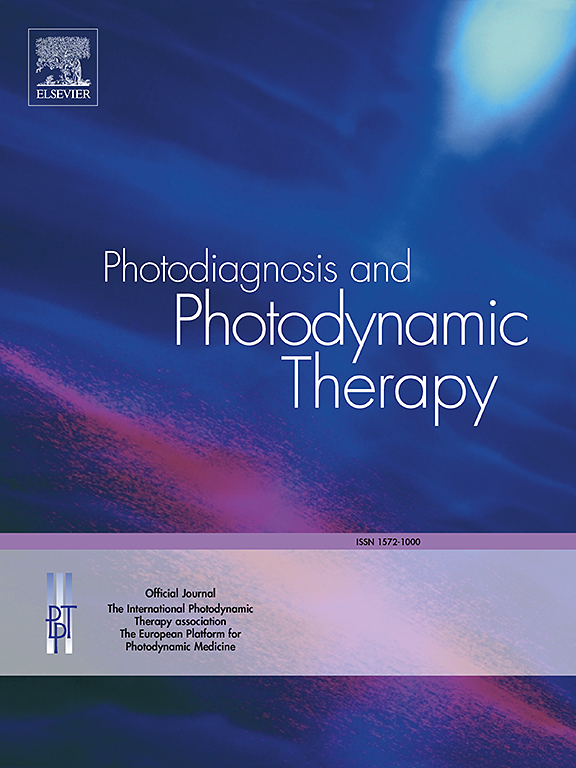Application of photodynamic therapy with 5-aminolevulinic acid and fractional CO2 laser for the management of recalcitrant plantar warts
IF 3.1
3区 医学
Q2 ONCOLOGY
引用次数: 0
Abstract
Significance
Plantar warts, benign lesions on the soles of the feet, are caused by the human papillomavirus (HPV) infecting keratinocytes. Complete eradication of these warts is challenging, often leading to recurrences. This study evaluates the combined clinical efficacy of topical 5-aminolevulinic acid (5-ALA) photodynamic therapy (PDT) and fractional carbon dioxide (CO2) laser treatment for recalcitrant plantar warts.
Approach
Data from 10 patients with recalcitrant plantar warts were analyzed. Initially, thickened hyperkeratotic tissue was removed using a super-pulsed CO2 laser. This was followed by fractional laser application, after which a 20 % 5-ALA cream was applied occlusively for 4 h. Patients then received He-Ne laser irradiation for 30 min at an energy density of 100 mW/cm², with treatments spaced 4 weeks apart.
Results
The study included 10 participants aged 24 to 53 years (mean age: 33.4 ± 8.09 years). In total, 40 lesions were treated across 1 to 9 PDT sessions, with an average of 5.2 ± 2.86 sessions per patient. Complete clearance was achieved in 3 patients (30 %), 4 patients (40 %) showed an excellent response (≥80 % improvement), while 2 patients had a partial response. One patient (10 %) showed <50 % improvement. The overall clearance rate was 70 % (28 out of 40 lesions). Aside from temporary pain during the procedure and mild erythema post-treatment, one patient developed localized proliferative scarring. After a one-year follow-up, only one patient experienced recurrence.
Conclusions
The combination of 5-ALA PDT and fractional CO2 laser therapy shows promise as an effective and safe alternative for treating persistent plantar warts.
应用 5-Aminolevulinic Acid 光动力疗法和点阵 CO2 激光治疗顽固性跖疣
意义重大:跖疣是足底的良性病变,由人类乳头瘤病毒(HPV)感染角质形成细胞引起。彻底根除这些疣具有挑战性,往往会导致复发。本研究评估了外用 5-aminolevulinic acid(5-ALA)光动力疗法(PDT)和点阵二氧化碳(CO2)激光治疗顽固性跖疣的综合临床疗效:方法:分析了10名顽固性跖疣患者的数据。首先,使用超脉冲二氧化碳激光去除增厚的角化过度组织。然后使用点阵激光,之后在局部涂抹 20% 5-ALA 乳膏 4 小时。然后,患者接受能量密度为 100 mW/cm² 的 He-Ne 激光照射 30 分钟,治疗间隔为 4 周:研究共包括 10 名参与者,年龄在 24 至 53 岁之间(平均年龄:33.4 ± 8.09 岁)。共有 40 个病灶接受了 1 至 9 次光导治疗,平均每位患者接受 5.2 ± 2.86 次治疗。3名患者(30%)获得了完全清除,4名患者(40%)获得了极佳反应(改善≥80%),2名患者获得了部分反应。一名患者(10%)出现了结论:5-ALA 光动力疗法和点阵 CO2 激光疗法的组合有望成为治疗顽固性跖疣的一种有效而安全的替代疗法。
本文章由计算机程序翻译,如有差异,请以英文原文为准。
求助全文
约1分钟内获得全文
求助全文
来源期刊

Photodiagnosis and Photodynamic Therapy
ONCOLOGY-
CiteScore
5.80
自引率
24.20%
发文量
509
审稿时长
50 days
期刊介绍:
Photodiagnosis and Photodynamic Therapy is an international journal for the dissemination of scientific knowledge and clinical developments of Photodiagnosis and Photodynamic Therapy in all medical specialties. The journal publishes original articles, review articles, case presentations, "how-to-do-it" articles, Letters to the Editor, short communications and relevant images with short descriptions. All submitted material is subject to a strict peer-review process.
 求助内容:
求助内容: 应助结果提醒方式:
应助结果提醒方式:


